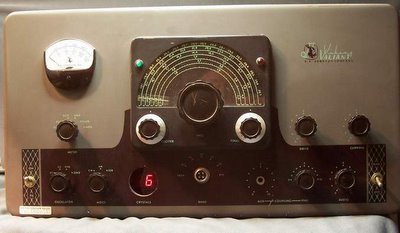
-
Guess you figured it out. At first I thought it was photograph that was digitally modified, but it's not - The comes straight to ya from Nomadradio, along with an inside picture as well!
-
Nomad writes, "This was shot during the assembly process, before the mike socket got wired up. The digits/channel selector/synthesizer is the same one seen in the Browning transmitters I use as forum sigs. Real product, perpetually sold nearly as soon as they're made. The two circuit boards in the upper half of this pic are: left) My replacement for the Glenn 326-1 board. It converts 16.270 MHz (channel 1) from the synthesizer to 26.965, for example. And right) the smaller board is a buffer, to beef up the drive level to match the 6CL6 driver tube. That same board goes into a Mark III SSB transmitter to bring up the weak drive level of a Siltronix or Glenn slider. The result is a mono band version of the original transmitter. The VFO dial is totally decorative. The entire VFO assembly and the "multiplier" tube are gone, along with the mode switch and the band switch. AM only, and (ahem) "10" meters. An antenna transfer relay, a coax for the receiver's antenna input, and muting are added to match a Browning receiver. With an adapter plug, it'll work with a normal ham or "communications" receiver with a mute jack on the rear panel. Problem is, nobody can afford it. Hence the disclaimer "Not a real product". Neither are the crazy concept cars at the auto show. Ever try to buy one of those? But it's a real radio, not just a PhotoFake."
-
He adds:
"Of course, what the first few folks who ask will get told is that this setup is still at the "prototype" stage. Normal rule is that the first two units that get done are the guinea pigs. The circuitry and component values get worked out on GP #1, until it functions as desired. GP #2 gets lead dress, layout and mounting locations optimised and cleaned up. At this stage, written instructions get edited and proofread. This forms the basis to do the same procedure to Guinea Pig number three. The instructions get proofread, yet again at each step of the procedure, and the labor documented. There's not much point in using the first two specimens to guess at the labor needed. Too much time spent "figuring out" stuff on those. Once GP #3 is proven to perform, the remaining mistakes in the directions corrected, and the labor added up, this is the first time anybody gets to hear a dollar price, or even an estimate. The unit in the pix is the current specimen. It's Guinea-Pig number two. Don't have number 3 lined up, yet. Once that third unit goes home, and performs in the owner's hands for a while, the materials and labor get added up one more time. "
-
"This is the point (finally) when a price will be quoted. Even then, with a radio that's 40-plus years old, it's only a "guesstimate" until the actual unit in question gets checked out. It's not just the years, it's the miles, too. You can tell if a Valiant was built from a kit or in the EF Johnson factory. If the tube sockets are held to the chassis with machine screws and nuts, it was probably a kit. If they are riveted to the chassis deck, it's probably a factory-built unit. There may be exceptions to that rule, don't know for sure. A radio with ALL good tubes would be cheaper to convert than one with empty sockets. What I'd really like to do with that tansmitter is work up a full-coverage 160-10 digital frequency synthesizer, with 10 or 25-Hz steps. A nice, large LCD display to put behind the original half-circle dial window. That WOULD be expensive to work up build. Never mind how much the first ten guinea pigs would have to pay for it. I keep promising myself I'm gonna play with this DDS chip-eval kit. Here's a thought: Hang a string of blue LEDs across the HV rectifiers after you replace them with silicons. That way you don't lose that ghostly blue-violet flicker from inside, in step with the voice audio. Hmmmmmmm...... "
-
Woody Sez....
"I think this is really cool, and Nomad (from my experience) is a decent guy (he's helped me out a couple times troubleshooting a radio. I'd say visit his site and congratulate him for this project"
'Nuff Said,
-